Geico266
Touchdown! Greaser!
Don't swap paint. 
That's in the FARS somewhere.


That's in the FARS somewhere.





A-ha! You argue the applicability, not the legality. You must then concede the legality of the exception to the rule which proves the rule exists: Traffic patterns do exist and must be flown unless covered under the exception. The legs are defined and diagrammed by the AIM/P&CG --a midfield crosswind does not even exist! Adios, my friend! I leave you with my sign:
Z

The legality of the applicability is moot. You do not contest the legality of 137.45 which is a legally required exception to traffic pattern operations.I'm arguing the legality as follows: The applicability section of Part 137 defines its scope, and thus any prohibition in that part only applies to operations within that scope.
I don't have to believe anything someone concludes for me.If you disagree, then you would have to believe that prohibitions in Sub-part F apply to all of Part 91, for example.
I don't have to believe anything someone concludes for me.
I threw out the bit about FAR 137.45 as a red herring to try to entice Jesse into arguing the applicability of the Part rather than him contesting the validity of the need to fly a traffic pattern unless specifically exempted by rule. He, though, did not take the bait--you did! So, I answered you as I had planned to answer him: The exception proves the rule. Traffic patterns are meant to be a requirement in Part 91. FAA has officially expanded on how they are to be flown in their literature. I don't and never really did care about the "applicability". Sorry my debate strategy drew you into it. Didn't mean to injure an innocent bystander.Let me rephrase: Do you believe that the statement of applicability in Subpart F of Part 91 limits the applicability of Subpart F, but the statement of applicability in Part 137 does not limit the applicability of Part 137? If so, why?

So, I answered you as I had planned to answer him: The exception proves the rule. Traffic patterns are meant to be a requirement in Part 91.

I threw out the bit about FAR 137.45 as a red herring to try to entice Jesse into arguing the applicability of the Part rather than him contesting the validity of the need to fly a traffic pattern unless specifically exempted by rule. He, though, did not take the bait--you did! So, I answered you as I had planned to answer him: The exception proves the rule. Traffic patterns are meant to be a requirement in Part 91. FAA has officially expanded on how they are to be flown in their literature. I don't and never really did care about the "applicability". Sorry my debate strategy drew you into it. Didn't mean to injure an innocent bystander.
137.45 in no way proves that "Traffic patterns are meant to be a requirement in Part 91."
 Seems like you're mistaken.
Seems like you're mistaken.No they're not, and I don't think your example implies that. There IS a requirement that all turns in the pattern be made to the left unless a right pattern is specified per 91.126(b). The exception you list in 137.45 would allow an ag operator to make right turns in the airport traffic area and thus is an exception to 91.126(b) which nobody is disagreeing on. 137.45 in no way proves that "Traffic patterns are meant to be a requirement in Part 91."
§137.45 Nonobservance of airport traffic pattern.
Notwithstanding part 91 of this chapter, the pilot in command of an aircraft may deviate from an airport traffic pattern when authorized by the control tower concerned. At an airport without a functioning control tower, the pilot in command may deviate from the traffic pattern if—
(a) Prior coordination is made with the airport management concerned;
(b) Deviations are limited to the agricultural aircraft operation;
(c) Except in an emergency, landing and takeoffs are not made on ramps, taxiways, or other areas of the airport not intended for such use; and
(d) The aircraft at all times remains clear of, and gives way to, aircraft conforming to the traffic pattern for the airport.Seems like you're mistaken.
Even you refer to the pattern requirement while denying there is one: "There IS a requirement that all turns in the pattern be made to the left unless a right pattern is specified per 91.126(b)."You making things bold does not change them. Go back and read my post again. They are giving ag ops the ability to break the only pattern requirement that exists in part 91, that is, 91.126(b). This does not imply that Part 91 was meant to have a pattern requirement. Even if it did imply that, Part 91 does not actually have a pattern requirement, so this whole thing is moot, even though you're still wrong.
Even you refer to the pattern requirement while denying there is one: "There IS a requirement that all turns in the pattern be made to the left unless a right pattern is specified per 91.126(b)."
I rest my case.
dtuuri
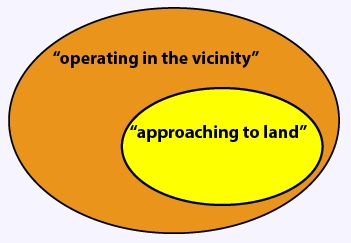

You can be en route to somewhere else and in the vicinity of an airport. Left turns wouldn't apply then. So, your geographic take in the above image is incorrect. The left turns apply to aircraft converging on the airport for landing sequencing, not aircraft trying to avoid that flow transiting the area.I just noticed that 91.126 on the whole is broadly about operating "in the vicinity" of an airport, but 91.126(b)(1) doesn't say that all turns should be to the left (or right) when you are "in the vicinity," but more narrowly, when you are "approaching to land"
While all approaches are "in the vicinity" (wherever that boundary is), aren't there places where you can legally make right turns while "in the vicinity" but not yet "approaching to land."?
You can be en route to somewhere else and in the vicinity of an airport. Left turns wouldn't apply then. So, your geographic take in the above image is incorrect. The left turns apply to aircraft converging on the airport for landing sequencing, not aircraft trying to avoid that flow transiting the area.
EDIT: I reread your post. I think I mistook it for a map. Sorry. If it was a conceptual drawing, then I believe you understand correctly after all.
dtuuri
In that case, you haven't got it yet. Aircraft can be approaching to land soon after takeoff at the departure airport, but aren't obligated to make left turns until "in the vicinity" of the destination. But the left turns only make sense in the context of a counter-clockwise flow around the whole airport, otherwise this nonesense would be perfectly legal:I thought this would arguably confirm that a midfield crossing and subsequent teardrop turn to the right are OK because they are merely "in the vicinity", whereas all of the subsequent turns that are part of the actual "approaching to land" are left turns.
A-ha! You argue the applicability, not the legality. You must then concede the legality of the exception to the rule which proves the rule exists: Traffic patterns do exist and must be flown unless covered under the exception. The legs are defined and diagrammed by the AIM/P&CG --a midfield crosswind does not even exist! Adios, my friend! I leave you with my sign:
Z


In that case, you haven't got it yet. Aircraft can be approaching to land soon after takeoff at the departure airport, but aren't obligated to make left turns until "in the vicinity" of the destination. But the left turns only make sense in the context of a counter-clockwise flow around the whole airport, otherwise this nonesense would be perfectly legal:
dtuuri
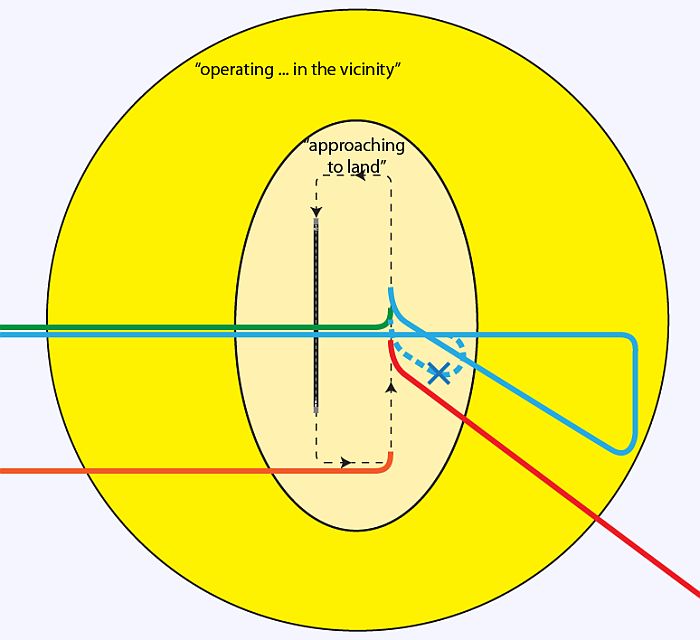
I didn't mean to imply you thought it was legal, only that the whole airport and not just a part of it needs to be the focus of the turn. There is a "difference", when in the vicinity, between "approaching to land" and "just passing by". So, you're correct in that way.Hi Dtuuri. Sorry, I'm not being clear. I'm not suggesting that it's legal to fly a right pattern by executing left 270s (that's crazy), I'm just suggesting that relative to 91.126 there might be a difference between being "in the vicinity" of the airport and actually "approaching to land" at the airport.
Right. If you are going somewhere else you don't need to make left turns as you approach the airport (the one you aren't going to anyway).In posts 36 and 50, you seem to be saying that the right turns associated with a teardrop turn to the 45 (shown in blue below) are illegal under 91.126(b)(1) because it involves incorrect turns while you're "in the vicinity" of the airport. However, 91.126(b)(1) actually says that the turns should be in the correct direction only when "approaching to land."
You seem to agree with me.Since the drafter used "in the vicinity" elsewhere, I believe that would have continued to use "in the vicinity" in (b)(1) if that's what they intended. They didn't, so "approaching to land" is a subset of the airspace that is "in the vicinity." Or, in other words, "in the vicinity" and "approaching to land" are not synonymous.
It's just a stupid theory, but I think that ALL of the solid color pattern entries shown here (red, green, blue, and orange) are perfectly legal, even the "blue" one used by the OP (this drawing is now logical and physical):

You're very welcome! I wish more people would go through them--I might have less work to do here.ps. Thanks for your website of awesome IFR lessons!

Since the drafter used "in the vicinity" elsewhere, I believe that would have continued to use "in the vicinity" in (b)(1) if that's what they intended. They didn't, so "approaching to land" is a subset of the airspace that is "in the vicinity." Or, in other words, "in the vicinity" and "approaching to land" are not synonymous.
You seem to agree with me.i
No I don't, but if they go out far enough "no harm, no foul". That's the rub. Nobody goes out far enough, so the practice should cease. But cutting straight across the center of the pattern at pattern altitude is even worse, so that shouldn't be a substitute. The best way when coming from the "other side" and when the runway in use is known is to join an upwind leg closer to the runway than you'd fly a downwind and then merge (follow, turn behind or break out of the pattern) with any departing traffic after passing the departure end of the runway. Only newbies and those exclusively used to controlled fields seem to balk at this. Those of us with lots of experience at uncontrolled airports with many radio-less aircraft find that to be the safest way to fit in to the flow and affords the best view and slowest closure rates.I may agree with you, but I'm not sure.
Do you believe that the right turns in the "tear drop" part of the solid blue pattern entry shown above are legal under 91.126?
... The best way when coming from the "other side" and when the runway in use is known is to join an upwind leg closer to the runway than you'd fly a downwind and then merge (follow, turn behind or break out of the pattern) with any departing traffic after passing the departure end of the runway. ...
So you don't misjudge when to turn crosswind. Say another plane is lifting off and you've passed the departure end of the runway and are flying parallel to it. If you're way out there away from the airport, by the time you make a turn and reach the extended centerline, the departing aircraft could have closed the gap on you. By being comfortably close to the runway instead, you're in a better postition to judge when you can safely make your turn. Just don't forget to look for closed traffic straggling up to the downwind leg off the crosswind (out there in the haze).Why closer?
Even you refer to the pattern requirement while denying there is one: "There IS a requirement that all turns in the pattern be made to the left unless a right pattern is specified per 91.126(b)."
I just noticed that 91.126 on the whole is broadly about operating "in the vicinity" of an airport, but 91.126(b)(1) doesn't say that all turns should be to the left (or right) when you are "in the vicinity," but more narrowly, when you are "approaching to land"
While all approaches are "in the vicinity" (wherever that boundary is), aren't there places where you can legally make right turns while "in the vicinity" but not yet "approaching to land."?

What case? If you think there's a requirement that a complete pattern be flown, you have no case to rest.
For example, yesterday I approached an airport with a north-south runway from the northeast. I turned a few degrees to the right about 10 miles out, and then made a left turn onto final for 18. Perfectly legal - My only turn in the pattern was to the left. The only real leg of the pattern I flew was final. Are you saying that was illegal, or not? If so, why?
It's just a stupid theory, but I think that ALL of the solid color pattern entries shown here (red, green, blue, and orange) are perfectly legal, even the "blue" one used by the OP (this drawing is now logical and physical):

The solid blue line is supposed to represent flying a couple of miles away from the runway before turning. If by "teardrop to the 45", people are referring to the dashed blue line that is executed in close proximity to the downwind, then I'm not a fan.
Who died and left you boss? Those are right turns, "in the vicinity" of an airport made by an aircraft "approaching to land" at it. What's not perfectly clear about that to you?Not to mention that all the different entries described by solid lines in this diagram are valid and not "illegal".
They do that. Get over it.So this seems to be more of a "do what I mean, not what I say" situation on the part of the FAA.

Didn't I say people have their own pet theories?Who died and left you boss? Those are right turns, "in the vicinity" of an airport made by an aircraft "approaching to land" at it. What's not perfectly clear about that to you?

Saying it's so don't make it so. The trouble with you is you don't know what's "legal" and what's just not worth making a federal case out of. Do a dipsie-doodle descending ampersand entry into a charter plane full of school children someday and I bet you find out.Didn't I say people have their own pet theories?
You can do whatever entry you want but all those on the diagram are valid.
The trouble with you is that you frequently make up your own version of what is legal. That entry I believe you are referring to is taught all the time. Personally, I don't use it but I know many who do.Saying it's so don't make it so. The trouble with you is you don't know what's "legal" and what's just not worth making a federal case out of. Do a dipsie-doodle descending ampersign entry into a charter plane full of school children someday and I bet you find out.
I'm here to correct those who don't know or should know better. You seem to be getting a lot of my attention lately.The trouble with you is that you frequently make up your own version of what is legal.

Look at page 9 of this document.I'm here to correct those who don't know or should know better. You seem to be getting a lot of my attention lately.
Your "dispy doodle ampersand entry" is described as a proper way to enter the pattern from the other side. I don't care what you think of me or how you enter the pattern yourself, but you spread false information here as if it was fact.One method of entry from the “opposite” side of the pattern is to cross over at least 500 feet above pattern altitude (normally 1,500 feet). When well clear of the pattern—approximately 2 miles— descend to pattern altitude and enter at 45 degrees to the downwind leg.
I don't have to look, I know all about it. I remember when they published it and how I called them up thinking there was a huge mistake--a typo-- and told them they need to publish a retraction ASAP before someone gets killed because nobody expects that. (At the time, I was mostly against the trek across the airport at traffic pattern altitude, and I still am, btw.) I've since tried to convince them in writing, but they won't change. It's telling that they do not base that document on any sort of study. It's also telling that AOPA employees are divided on the "recommendations", choosing to sit at separate tables during lunch in the cafeteria on at least one occassion (I know a witness).Look at page 9 of this document.
As I said, you have your own pet ideas. Nothing wrong with that except when you try to pass them on to others as the only approved way to do things. Now, as Jesse said earlier in the thread, go find someone else to argue with.I don't have to look, I know all about it. I remember when they published it and how I called them up thinking there was a huge mistake--a typo-- and told them they need to publish a retraction ASAP before someone gets killed because nobody expects that. (At the time, I was mostly against the trek across the airport at traffic pattern altitude, and I still am, btw.) I've since tried to convince them in writing, but they won't change. It's telling that they do not base that document on any sort of study. It's also telling that AOPA employees are divided on the "recommendations", choosing to sit at separate tables during lunch in the cafeteria on at least one occassion (I know a witness).
And, yes, I also know the FAA lists the document in a "for further reading" bibliography in an Advisory Circular on non-towered airport operations. I doubt they even read it to vet it first, since they've never drawn or described any such maneuvers themselves.
Part 91.126 is the only "approved way". Your cite is nothing.Nothing wrong with that except when you try to pass them on to others as the only approved way to do things.
I'm here to correct those who don't know or should know better. You seem to be getting a lot of my attention lately.

Part 91.126 is the only "approved way". Your cite is nothing.
dtuuri
The Great Debate
April 1, 1997 By Bruce Landsberg
Over the years I've learned that there are some topics that you really should avoid if you wish to maintain civility with your conversation partners. These include politics, religion, ethnic jokes, and — for many pilots — traffic patterns. There are few subjects that generate as much heat or difference of opinion as how to operate at nontowered airports.
The debate has been raging for years, and one of the key questions is where to enter a traffic pattern when a flight is approaching from the opposite side of the downwind leg. The passions run deep, ***
To some pilots the pattern is sacred. ***
To see how widespread the confusion was, we asked AOPA members and CFIs their thoughts on opposite-side pattern entry. The opinions were strong and varied, but two distinct categories emerged: There were the crossovers who crossed the runway at right angles, say 500 feet above pattern altitude; went several miles away from the airport; descended to pattern altitude; and turned onto the 45-degree entry leg to the downwind.
The other major group was the upwinders, who entered the pattern on the upwind leg at pattern altitude and turned crosswind somewhere near midfield to avoid arrivals and departures. If the description sounds somewhat muddy, the execution is relatively smooth. I have used this procedure at several airports where there was some restriction to the normal 45-degree downwind entry because of airspace, traffic, or noise abatement plans, and it works. One point for the crossover crowd to remember is that the standard pattern altitude is 1,000 feet agl for light aircraft and 1,500 feet agl for twins and turbine equipment. To avoid that rundown feeling, watch and listen carefully as you pick your altitude to get to the other side.
***
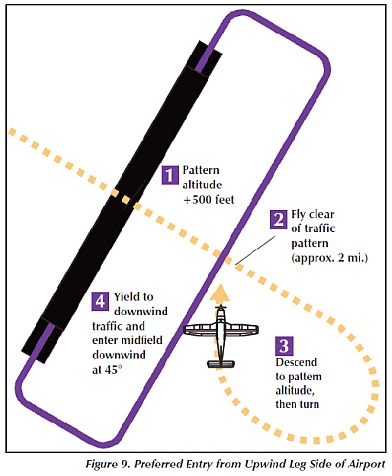
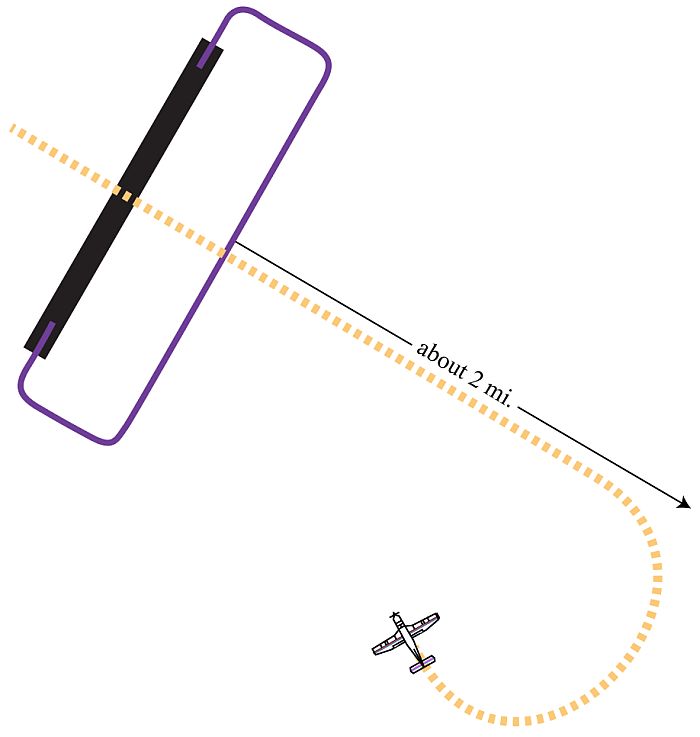
You've got your own misconceptions to work on, you don't have time to rescue her.You're gonna lose this one. Mari is not only a very experienced pilot, she's also one of the most respected members of this board.
And you haven't provided any citations that are worth a crap in this discussion. "Because I said so" ain't gonna fly here.
Very good research. I actually thought the original article I saw in the AOPA Pilot magazine was before that. IIRC, I was on a corporate trip reading magazines, killing time, and read this in an article. I called immediately. But I was brushed off and I didn't realize this was a reprint of a "paper". I did not belong to AOPA and never became a member until a few years ago. When I started participating on the Red Board I learned the rest. So, I again protested and again was rebuffed. You have uncovered the smoking gun:Given that it's now 2014, this old article written by AOPA's Senior Safety Advisor, Bruce Landsberg, is aptly entitled "The Great Debate":
http://www.aopa.org/News-and-Video/All-News/1997/April/1/The-great-debate
The AOPA publication called "Operations at Nontowered Airports, referenced above in post 72, was published at least as early as 1998, and re-published at least as late as 2013.
It shows this:
That's fine so far as it goes, but since the legend says you should "fly clear of traffic pattern (approx. 2 mi.)" before descending to TPA and then turning, it should VISUALLY suggest that you fly farther way before turning - something like this:
Dturri, have you been actively debating this topic since before 1997?
***
Enter upwind, fly around the field, join the downwind, yes. Not cut OVER the field, 90° to the downwind from the inside. Crazy.
***
EDIT: As for the "amersand drop", I used to teach it myself until I made my living going into and out of sleepy little airports all the time. I wised up and changed. I think 91.126 is very elegant--circle left as you approach it and gently merge with the other traffic. Avoid acute (obtuse?), i.e., head-on, closing angles and fast converge speeds.
dtuuri
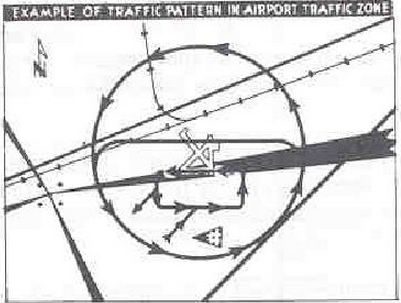
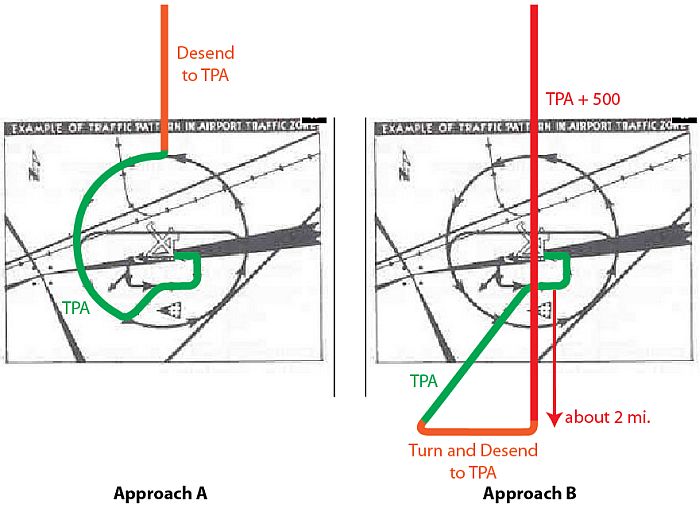
a. Prior to entering the traffic pattern at an
airport without an operating control tower, aircraft
should avoid the flow of traffic until established
on the entry leg. For example, wind and landing
direction indicators can be checked while at an
altitude above the traffic pattern. When the proper
traffic pattern direction has been determined, the
pilot should then proceed to a point well clear
of the pattern before descending to the pattern
altitude.
